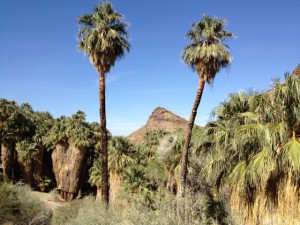John Van Dyke, in his epic visit to the deserts of western North America a century ago, wrote harshly of their springs:
Occasionally one meets with a little stream where a fissure in the rock and a pressure from below forces up some of the water; but these springs are of very rare occurrence. And they always seem a little strange. A brook that ran on the top of the ground would be an anomaly here; and after one lives many months on the desert and returns to a well-watered country, the last thing he becomes accustomed to is the sight of running water.
In every desert there are isolated places where water stands in pools, fed by underground springs, where mesquite and palms grow, and where there is a show of coarse grass over some acres. These are the so-called oases in the waste that travellers have pictured as Gardens of Paradise, and poets have used for centuries as illustrations of happiness surrounded by despair. To tell the truth they are wretched little mud-holes; and yet because of their few trees and their pockets of yellow brackish water they have an appearance of un-reality.
Wretched or not, I have loved them all my life – the turn of a bend on a desert canyon trail, to come upon a grove of cool palms. Which is why Ian James’ story in the Desert Sun this morning made me so sad:
As a boy in the late 1940s, Harry Quinn hiked with his family to a desert spring in the Santa Rosa Mountains where cool water flowed into an oasis filled with tadpoles.
Now the spring is dry. The tadpoles and toads are long gone. Four palm trees remain in the dry canyon, two of them dead.
“This was a special place,” said Quinn, now 75, as he walked through the remnants of the oasis known as Dos Palmas. “You just can’t come here and get a drink anymore.”
There’s some science here – dwindling snowpack feeding the aquifers that find their way to the fissure in the rock, warming temperatures, that sort of thing. But mostly for me it’s just sad, one more piece of my childhood fading into the past.

